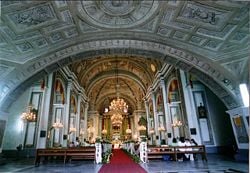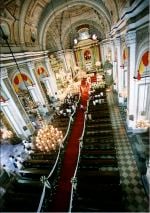Difference between revisions of "Baroque Churches of the Philippines" - New World Encyclopedia
Dan Davies (talk | contribs) |
Dan Davies (talk | contribs) |
||
| Line 122: | Line 122: | ||
== Nuestra Señora de la Asuncion in [[Santa Maria, Ilocos Sur]] == | == Nuestra Señora de la Asuncion in [[Santa Maria, Ilocos Sur]] == | ||
| + | |||
| + | <!-- | ||
| + | THE CHURCH AND CONVENT | ||
| + | |||
| + | The majestic church, convent and tower built atop a knoll, and with an air of a medieval cathedral-fortress about them, have definitely intrigued many, not the least of whom are present writers. | ||
| + | |||
| + | Like most Philippine churches, legend has been associated with the Santa Maria church. It is said that the original chapel dedicated to the Blessed Virgin was built at a site in the present day barrio of Bulbullala. The statue of the virgin enthroned in that small chapel, so the legend goes, periodically disappeared and was always subsequently found on a guava tree at the site of the present main altar of the church. | ||
| + | |||
| + | Father Mariano Dacanay, the town's Ilokano parish priest from September 1, 1902 to May 27, 1922, has written another variant to this legend which, he assures us, has been obtained from reliable sources. The virgin's statue, Fr. Dacanay relates, was enthroned in another church (not the chapel at Bulbullala) which used to be situated in the present East Elementary School compound at the foot of the present East Elementary school compound at the foot of the present church. It was from here, Fr. Dacanay adds, that the image made its peregrinations to that guava tree on the knoll where the church now stands. | ||
| + | |||
| + | Legends about the virgin have indeed become part of Philippine religious lore, and, if these legends are to be believed, the Virgin herself made known her preference for her permanent home. Almost invatiably a tree is associated with this, and possibly among the most celebrated being that of the Nuestra Senora de Guia who made known her wish by lodging on a pandaan tree on the site where the Ermita church now stands. Viewed againts this backdrop, the Santa Maria legend about the Virgin is, thus, nothing extraordinary. | ||
| + | |||
| + | Be that as it may, a chapel and a tower were built in 1810. The records failed to specify what chapel built at the present site of the church? Or was it actually the small church built on the present site of the East Elementary School? To us, it would seem that the first case was more likely, as no tower, nor even ruins of it, are found below the knoll. Thus, the legend, as recounted by Fr. Dacanay, makes more sense than the other one. | ||
| + | |||
| + | Records also show that the bells for the tower arrived in 1811. In 1822 the convent and church were razed to the ground (again, one is tempted to ask: Whichconvent and which church?). It seems likely that what is meant here were the convent and the church below the knoll. | ||
| + | |||
| + | Nevertheless, the zealous Fr. Bernardino Lago later made Santa Maria a center of his missionary activities for the interior settlements. This may, indeed, explain the (reconstructed?) huge church and convent, and the presence of many side altars in church.. Thus, there seems reason to believe that newly arrived missionaries learned Ilokano psychology and perfected their knowledge of the Ilokano language in Santa Maria before they were sent to neighboring mission posts. Or again, it appears possible that the convent provided a retreat housefor weary Augustinian missionaries from their intense apostolic labors, and for sickly or aging friars. | ||
| + | |||
| + | Fr. Lago converted thousands which necessitated the establishment of the town of Nueva Coveta, the present town of Burgos, in 1831. | ||
| + | |||
| + | In 1863, the church was remodelled, and the sides of the knoll surrounding it, the convent and the tower, reinforced with huge stone boulders kept in place by mortar, a task which must have taken a heavy toll, as it lasted up to 1871. Thus, people began to react against forced labor, and took no pain to hide it. | ||
| + | |||
| + | Obviously, the Santa Marians had not completely forgotten the Diego Silang rebellion in 1762 during the British occupation, and which must have convinced them that the Spaniards were not invincible after all. They also must not have easily forgotten the Sarrat rebellion in 1815, nor the more recent Cavite revolt headed by Camerino in 1869. For while it is true that communication was primitively slow (mails, however, were sent from, and received in Santa Maria in as early as the 1850s), it is equally true that they received news from the outside world somehow or the other. | ||
| + | |||
| + | {{credits|212433632}} | ||
| + | —> | ||
== San Agustin Church in [[Paoay, Ilocos Norte]] == | == San Agustin Church in [[Paoay, Ilocos Norte]] == | ||
Revision as of 20:55, 14 May 2008
| Baroque Churches of the Philippines* | |
|---|---|
| UNESCO World Heritage Site | |

| |
| State Party | |
| Type | Cultural |
| Criteria | ii, iv |
| Reference | 677 |
| Region** | Asia-Pacific |
| Inscription history | |
| Inscription | 1993 (17th Session) |
| * Name as inscribed on World Heritage List. ** Region as classified by UNESCO. | |
The Baroque Churches of the Philippines is the official designation to a collection of four Spanish-era churches in the Philippines, upon its inscription to the UNESCO World Heritage List in 1993.
The collection is composed of the following:
- San Agustin Church in Manila
- Nuestra Señora de la Asuncion in Santa Maria, Ilocos Sur
- San Agustin Church in Paoay, Ilocos Norte
- Sto. Tomas de Villanueva Church in Miag-ao, Iloilo
On August 15, 1993, these churches, along with the one in Baclayon, Bohol were nominated for World Heritage Site status as part of the Jesuit Churches of the Philippines.
On May 16, 2006, the NCCA nominated a new set of churches as part of the extension of the Baroque Churches of the Philippines World Heritage Site. With the inclusion of two churches from the Jesuit Churches nomination, these two proposals will likely be combined.
San Agustin Church in Manila
Nuestra Señora de la Asuncion in Santa Maria, Ilocos Sur
San Agustin Church in Paoay, Ilocos Norte
Sto. Tomas de Villanueva Church in Miag-ao, Iloilo
Description
These churches have been at the forefront of Philippine history, not just in furthering Christianity in the archipelago, but in serving as the political backbone of Spanish colonial rule, when Church and State was regarded as one. The unique architecture of the churches didn't just reflect the adaptation of Spanish/Latin American architecture to the local environment (including the fusion with Chinese motifs), but also of the Church's political influence. These churches had been subject to attacks by local revolts and rebellions, hence, most had the appearance of a fortress, rather than just serving as mere religious structures. This is especially noteworthy in the case of Santa Maria Church, located on top of a hill, serving as a citadel during times of crisis. Miag-ao Church also withstood the occasional attacks of Muslims from the south. Further, the location of the Philippines along the Pacific Ring of Fire called for the emphasis on the buttresses and foundations of these churches, with some being seriously damaged, but eventually rebuilt after an earthquake. The most imposing of these buttresses could be found in Paoay Church, while the true testament of this architecture could be seen in San Agustin Church, Manila, the only structure in Intramuros to survive World War II. Hence, the unique architectural style became known as Earthquake Baroque.
Greater protection

Aside from these four churches, the Philippine National Commission for Culture and the Arts (NCCA) has also designated the conservation and protection of 26 other Spanish-era churches to be of utmost importance. These were registered as National Cultural Treasures.
These churches were given priority status not just due to their historical value, but also based on the geographic representation of various regions across the nation:
- Parish Church of San Agustin in Bacong, Negros Oriental
- Parish Church of the Immaculate Conception in Balayan, Batangas
- Parish Church of Santiago Apostol in Betis Guagua, Pampanga
- Parish Church of Patrocinio de Maria in Boljoon, Cebu2
- Parish Church of Saints Peter and Paul in Calasiao, Pangasinan
- Parish Church of San Vicente de Ferrer in Dupax del Sur, Nueva Vizcaya
- Parish Church of the Immaculate Conception in Guiuan, Eastern Samar1 2
- Parish Church of the Immaculate Conception in Jasaan, Misamis Oriental
- Parish Church of San Juan Bautista in Jimenez, Misamis Occidental
- Parish Church of San Isidro Labrador in Lazi, Siquijor2
- Parish Church of San Pedro and San Pablo in Loboc, Bohol1 2
- Parish Church of Santa Catalina de Alejandria in Luna, La Union
- Parish Church of San Carlos Borromeo in Mahatao, Batanes
- Parish Church of San Guillermo de Aquitania in Magsingal, Ilocos Sur
- Parish Church of San Gregorio Magno in Majayjay, Laguna
- Parish Church of the Assumption of Our Lady in Maragondon, Cavite1
- Parish Church of San Andres in Masinloc, Zambales
- Parish Church of Santa Monica in Panay, Capiz
- Cathedral of San Jose in Romblon, Romblon
- Parish Church of San Raymundo de Peñafort in Rizal, Cagayan
- Parish Church of San Joaquin in San Joaquin, Iloilo
- Parish Church of San Juan Bautista in Tabaco City, Albay
- Parish Church of San Ildefonso in Tanay, Rizal
- Basilica of St. Michael Archangel in Tayabas, Quezon
- Parish Church of Santa Catalina de Alejandria in Tayum, Abra
- Parish Church of San Matias in Tumauini, Isabela
- Parish Church of Santa Maria Magdalena in Kawit, Cavite
- Parich Church of Nuestra Señora Virgen del Rosario de Caracol Rosario, Cavite
External links
- World Heritage profile
- NCCA's 26 Churches' profile
- Nomination of Jesuit Churches of the Philippines as a World Heritage Site
- Nomination for the Extension of the Baroque Churches World Heritage Site
| |||||||
[[Category:]]
Credits
New World Encyclopedia writers and editors rewrote and completed the Wikipedia article in accordance with New World Encyclopedia standards. This article abides by terms of the Creative Commons CC-by-sa 3.0 License (CC-by-sa), which may be used and disseminated with proper attribution. Credit is due under the terms of this license that can reference both the New World Encyclopedia contributors and the selfless volunteer contributors of the Wikimedia Foundation. To cite this article click here for a list of acceptable citing formats.The history of earlier contributions by wikipedians is accessible to researchers here:
The history of this article since it was imported to New World Encyclopedia:
Note: Some restrictions may apply to use of individual images which are separately licensed.